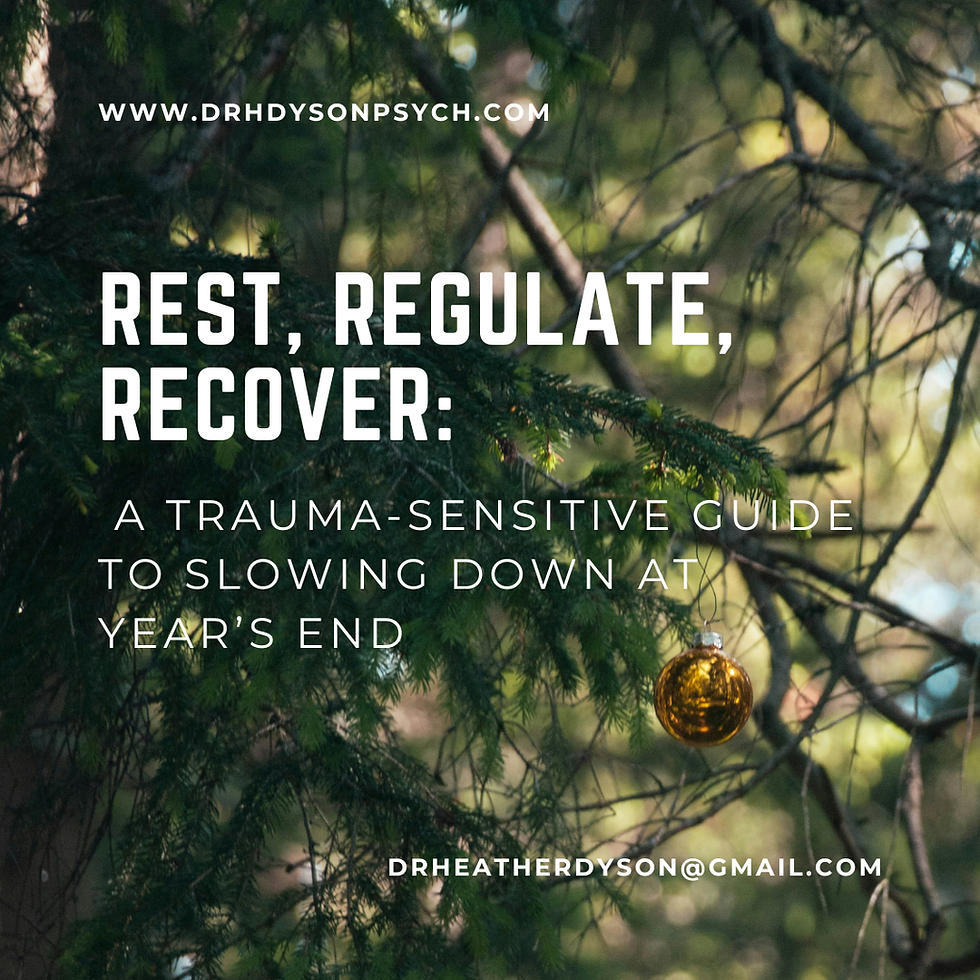Self-Care for Survivors of Trauma: Five Practical Tips for Taking Care of Your Mental Health
- Dr Heather Dyson

- May 30, 2023
- 4 min read

Survivors of trauma often face unique challenges when it comes to maintaining their mental health. Experiencing traumatic events can have long-lasting effects on a person's well-being, making self-care an essential component of their healing journey. In this blog, we will explore five practical tips for self-care specifically tailored to survivors of trauma. These tips aim to empower individuals to prioritise their mental health and build resilience as they navigate the path towards healing.
1. Seek Professional Support:
One of the most crucial steps in the self-care journey for trauma survivors is seeking professional support. Trauma-informed psychologists specialise in understanding the complexities of trauma and can provide valuable guidance and support. They create a safe space for survivors to explore their experiences, process emotions, and develop healthy coping mechanisms. Therapeutic modalities such as cognitive-behavioral therapy (CBT), eye movement desensitisation and reprocessing (EMDR), and mindfulness-based interventions have shown effectiveness in trauma recovery. Remember, reaching out for help is not a sign of weakness but a courageous step towards healing.
2. Establish a Supportive Network:
Building a supportive network is another crucial aspect of self-care for trauma survivors. Surrounding yourself with individuals who understand and empathise with your experiences can make a significant difference in your healing process. Seek out support groups or community organisations that focus on trauma recovery. Connecting with other survivors can foster a sense of belonging, reduce isolation, and provide a space to share experiences and coping strategies. Online platforms and social media communities can also offer a supportive environment, allowing survivors to connect with individuals from diverse backgrounds and share their stories.
3. Prioritise Self-Compassion and Self-Acceptance:
Self-compassion and self-acceptance are transformative tools for survivors of trauma. It is crucial to acknowledge that healing is a non-linear process, and everyone's journey is unique. Treat yourself with kindness and compassion, recognising that you are doing your best. Practice self-care activities that promote self-acceptance, such as journaling, meditation, or engaging in creative outlets like art or music. Challenge negative self-talk by consciously reframing your thoughts and focusing on self-empowering affirmations. Embrace self-care rituals that nurture your mind, body, and soul, allowing space for healing and growth.
4. Engage in Mindful Practices:
Mindfulness practices can be particularly beneficial for trauma survivors. Mindfulness involves paying attention to the present moment without judgment, allowing you to develop a deeper understanding of your emotions and sensations. Engaging in mindfulness exercises, such as deep breathing, body scans, or guided meditations, can help regulate stress responses and increase self-awareness. Additionally, practicing grounding techniques, such as naming objects in your environment or focusing on your senses, can help bring you back to the present during moments of distress or dissociation. By cultivating mindfulness, you can foster a sense of calm and reduce anxiety while developing resilience in the face of triggers.
5. Take Care of Your Physical Well-Being:
Taking care of your physical well-being is an essential aspect of self-care for trauma survivors. Trauma can have a significant impact on the body, and incorporating practices that promote physical health can complement your mental healing. Engage in regular exercise or physical activity that suits your preferences and abilities, as it can release endorphins, reduce stress, and improve sleep quality. Ensure you are nourishing your body with a balanced diet, as proper nutrition can support your overall well-being. Prioritise regular sleep patterns and establish a bedtime routine that promotes relaxation. By caring for your physical health, you are creating a solid foundation for your mental and emotional healing.
Self-care plays a crucial role in the healing journey of trauma survivors. By implementing these five practical tips, individuals can take proactive steps towards nurturing their mental health and building resilience. Seeking professional support provides the guidance and tools necessary to navigate the complexities of trauma recovery. Building a supportive network allows survivors to connect with others who understand their experiences and provide validation and encouragement. Cultivating self-compassion and self-acceptance allows survivors to embrace their journey with kindness and understanding, acknowledging that healing takes time. Engaging in mindful practices helps survivors stay present, manage triggers, and develop a deeper connection with their emotions and sensations. Finally, prioritising physical well-being complements mental healing, as it supports the body's overall health and vitality.
It is important to remember that self-care is a personal journey, and what works for one person may not work for another. It is crucial to explore different strategies and techniques and find what resonates with you individually. Additionally, self-care is not a one-time event but an ongoing practice that requires consistency and commitment. It is normal to experience setbacks or challenges along the way, but with perseverance and self-compassion, healing is possible.
In short, self-care for survivors of trauma is an essential aspect of their healing process. By seeking professional support, building a supportive network, practicing self-compassion, engaging in mindful practices, and taking care of their physical well-being, survivors can prioritise their mental health and foster resilience. Remember, healing takes time, and every step towards self-care is a step towards reclaiming your life and finding joy and peace within yourself.
Photo by Matthew Smith on Unsplash




Comments